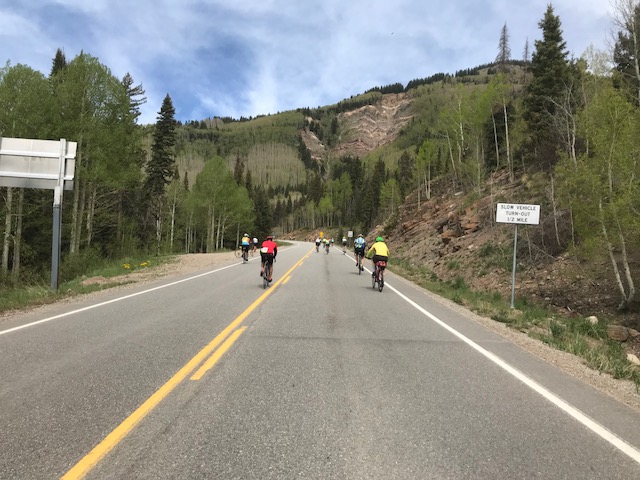The IHBC is a true Colorado Classic, having started in 1972 when a couple of bored guys decided to race the Durango-Silverton narrow-gauge train. Since then, it’s blossomed into a great weekend of cycling in Durango. You also know it’s a classic, because it says so right in the name.
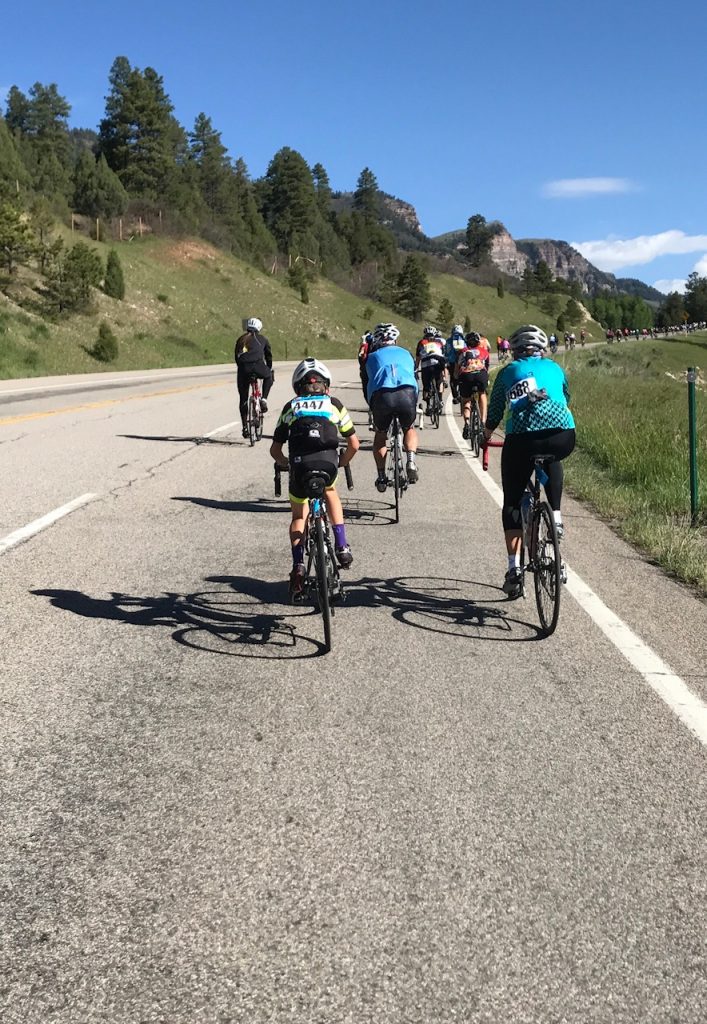
Over the years, it has evolved into a variety of events, including the famous race against the train, mountain bike racing, BMX events, and a new (2017, 2018) gravel event. I’ve been fortunate enough to do the road ride to Silverton more times than I can remember. Really, I don’t remember how many times I’ve been to Durango for this weekend. Suffice to say, more than a few, less than a lot. Age and memory don’t necessarily go hand-in-hand. I’ve seen good weather and bad, have never beaten the train but have also never had a bad time.
As with all things internet-y, you can search up your own reviews and info about the event as there are many, many sites which give a modicum of information. Go ahead, use the Googles all by yourself to find that stuff, then once you’ve read it, you’ll see much of the same veneer-deep text the internets have perfected. Here at MamilMusings, though, our staff of irritable and grumpy old men think that there is not enough useful information out there, so we provide it here, free of charge.
Firstly, as with all types of famous events, register early. Duh. Get your hotel early, too, as they will fill up quickly. Durango, a city of about 18,000 people, has a good selection of hotels, so do your research and get one. The road events, mountain bike races, BMX, and gravel events all start downtown (although the road races start a bit north, adjacent to the high school and fairgrounds). The downtown core has ample restaurants, bars, and shopping, so if you can get a hotel within a short walking or riding distance, it’s well worth it.
Secondly, it’s really important to keep in mind that this weekend happens at high altitude. Durango, at 6,500′ is not hugely high by Colorado standards, but the road events go over 10,900′, which is significant. For those coming from low altitude, hydration (water, not beer) is critical. This is a desert area as well, so humidity is low and you will lose water faster than you think. Another huge factor in the altitude and significant climbing is weather: plan for snow and you won’t be disappointed. Even if it’s gorgeous and warm in town, it can be snowing on either Coal Bank or Molas Passes. The finish, in Silverton, is at 9,300′, and the weather can get really sketchy there too.
The mountain bike races all start and finish from the center of downtown and have a multiple-lap format. This too has evolved, most recently with all categories climbing the alley and ramp behind Steamworks Brewing, before progressing through the bar itself and exiting a window at the front of the building. If you can get inside (good luck), it’s a great way to spend a few rowdy hours watching the race. I pre-rode the mountain bike race a few years ago with every intention of competing on my single-speed, but my then-5-year-old son saved me from Lanterne Rouge duties by getting his finger stuck in a toy, leading to an early-morning visit to the ER. Since then, I have not ridden the mountain bike course, but I do remember it being 1) fun, and 2) painful.
Recent additions of BMX and Gravel events have improved the visitor experience and branched into new formats. The inaugural La Plata La Strada Gravel Ride (not a race, they keep repeating, in case insurance agents and local authorities are eavesdropping) in 2017 was a great course, with smooth gravel, a couple of very steep climbs, and a long climb designed to reduce your spirit to a quivering, useless mass. The 2018 course was significantly different, but was put on hold when a guy with a gun managed to light a forest fire that threatened many homes and caused evacuations. His deft marksmanship (sparksmanship?) also reclassified the gravel event as Totally Fuct as the planned course was now partially on fire. Kudos to the organizers, though, who managed to cobble together a great alternative route, complete with gravel and headwinds. No easy task to pull off when you cancel your event only 12 hours before the scheduled start, and they managed it quite well.
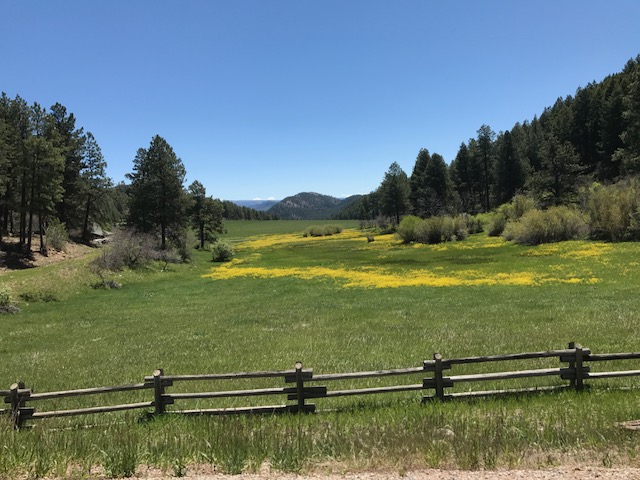
2017 Gravel images

The BMX event started as a long rhythm section with head-to-head racing down Main Street in 2017, which made for great spectating. For 2018, they ran it perpendicular to Main, taking advantage of the steep cross streets. The inclusion of a shipping container as a pedestrian tunnel/huge jump added to the spectacle, and after a few hours of practice, many backflips and other tricks kept the crowd entertained. Expect this to continue in the future.
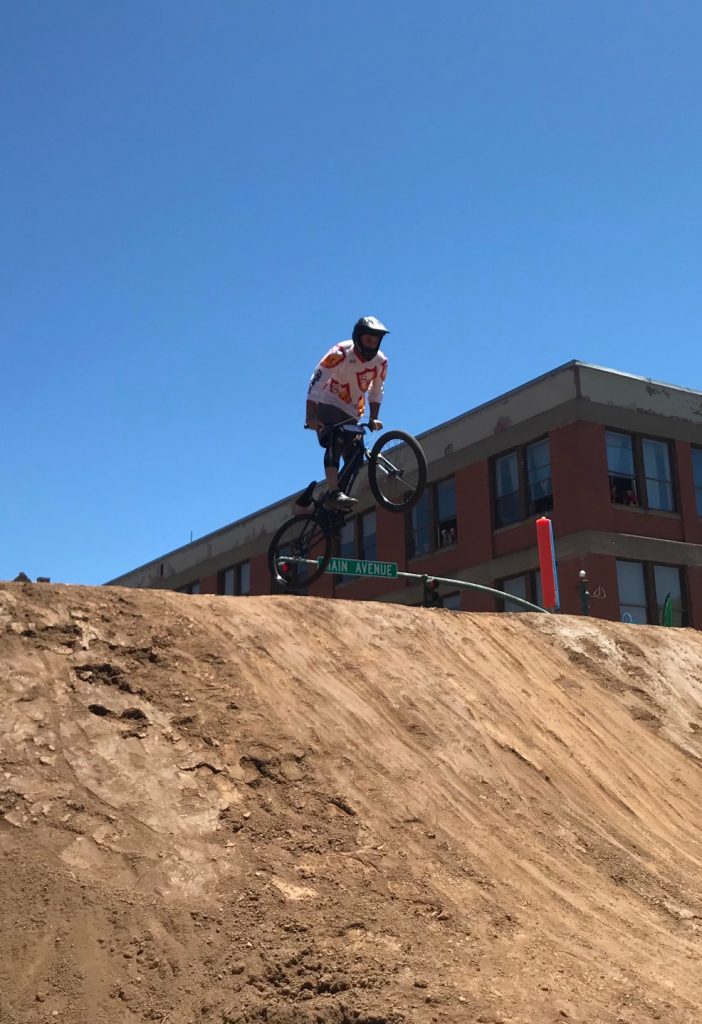
Other events, such as the Clunker Crit, keep the cycling party going late into the evening on Sunday.
Durango-Silverton Need-to-Know info:
Altitude: You’ve heard about it, read about it, and now you deal with it. Hydrate, breathe deep, and remember, that if you go into the red, recovery is really hard.
Return from Silverton: The IHBC offers buses from Silverton back to Durango and box trucks for bikes. You can drop a bag of clothes at registration on Friday night, make sure you include a sweatshirt and I recommend long pants. It’s rare for Silverton to be warm in the spring (or summer, or fall, or winter for that matter). This is generally worth it, unless you can drop a car in Silverton or convince (bribe) someone to get past Purgatory before the road closes at 8AM (I think. Maybe it’s 8:30, but tell them it’s 8 or you’re running the risk of being well and truly screwed). If you do park in Silverton, stay off Main Street. Again, warm clothes in that car can make the difference between it being Type I Fun or Type II Fun.
There are many bars and restaurants in Silverton, and the town has a very different feel than in the winter months. Summer is obviously high tourist season, and this is one of their biggest days, especially with clientele who can’t leave until the road opens. I first visited Silverton when their ski area opened, and returned with friends for several years for excellent challenging skiing. In the winter, finding food and drinks was even more challenging, but in recent years more places are open for skiers. We had visited several times before Main Street was paved, and as of 2018, I think it’s still the only tarmac in town off the highway.
Stuff no one tells you about the road ride: Although Coal Bank and Molas Passes are the stars here, Hermosa Hill, about 13 miles from town, is the first big climb, and it hurts. With grades over 8%, it’s a hard climb and ugly wake-up call. One thing that is often missed is that the two passes are beyond Purgatory, but they only have 1/2 the climbing. This means that even those who opt for the shorter Quarter Horse ride are still climbing about 3,000′ and face some fairly tough grades. Don’t burn all your matches too soon. Also, the Quarter Horse is challenging despite its shorter distance, with the last climb to Purgatory quite steep and twisting up to the ski area. It’s a great ride if you don’t quite have the legs for Silverton, and my 10-year old son did it with his buddy in 2017, so it’s not out of reach for kids. Note that the road is open here, so you need to be aware of traffic, although it’s usually pretty quiet.
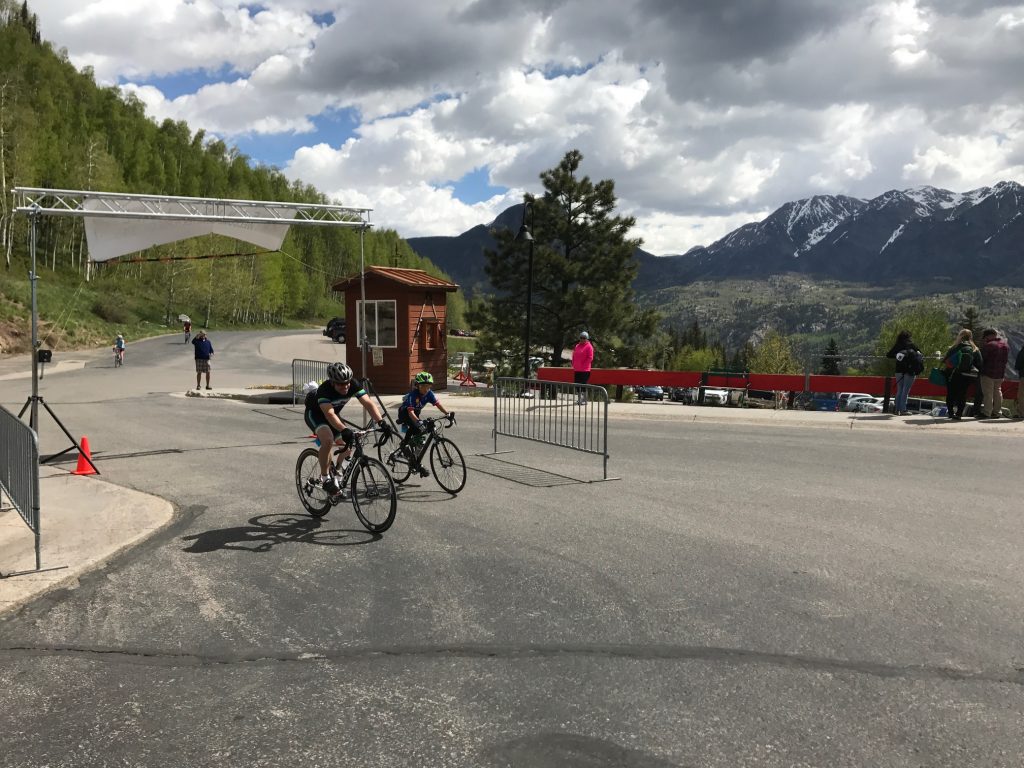
2017 Quarter Horse finish
Coal Bank Pass, with a 5.4 mile climb, is steeper than you might hope or want. It spends quite a bit of time north of 7%, with only small ramps below 6%. The climb itself is beautiful, but the 4 Miles to Go sign can also shatter your dreams of a quick climb. There is an aid station at the top, where it is highly recommended you add a layer for the 3 mile descent to the start of Molas. The road surface is generally good and well maintained by Colorado standards (which are, admittedly, alarmingly low). Watch the turns, they are not banked well.
Molas Pass starts at Lime Creek, a huge hairpin turn. the actual grade change is a bit earlier, and you pass a 4 Mile to Go sign, but it doesn’t feel like it starts until the big turn that swings the road directly into the headwind/ Don’t let this discourage you, though, as it isn’t noticeable after the next turn, a few hundred yards farther up. The roughly 3.5-mile climb is somewhat easier than Coal Bank, with slightly lower grades and a shorter distance. The challenge here is that it’s the third big climb of the day, as well as the highest. Once at the top, the views are spectacular, but please focus on the road. Stop at the aid station, put on a layer, and head downhill. The descent from Molas to Silverton is a bit over 7 miles, and the road is actually surprisingly good, having been widened in some sections and repaved relatively recently. After an initial steep, sweeping turn, the road flattens a bit over high alpine meadows, before clinging to the sides of the hill and becoming more technical.
Once you complete the final sweeping left turn into Silverton, you have the entire length of Main Street waiting for you as the finish is at the far end. Main Street is also a 2-3% grade, and it feels more like 10%. The altitude and climbing already in your legs will make them burn like a Disco Inferno never could. Once across the line, you can head into the park to find a beer or food.
As stated earlier, plan for weather and you won’t be disappointed. Arm warmers, leg warmers, wind shell, and so forth can save you from a lousy ride, and in the worst case, only add a bit of stuff to carry.
The road is closed to cars from Purgatory to Silverton until 1:30PM, which is one of the best aspects of the event. This also means that there are cut-offs at Coal Bank (12:30) and Molas (1:30). If you miss these cutoffs, you’ll ride the bus from here. Many people on the citizen’s tour (not race) will start early to give themselves ample time to make the time cuts, so don’t be surprised to see a trickle of riders heading north from town before the official 8AM start. Traffic is controlled and slightly detoured between Durango and Purgatory, but watch out for cones. I’ve seen plenty of crashes from people hitting them.
As always, read the ride guide carefully and check your email for updates prior to putting on your chamois as things can change quickly in the mountains.
Logistics:
Durango is accessible from all directions, but the most interesting approach is from the north on Highway 550 from Ouray. Also known as the Million Dollar Highway, this road is not for the faint-of-heart, but it is pretty awesome. Guardrail-free and very narrow, it clings to the edge of a cliff for the first climb out of Ouray, a lovely town with numerous restaurants and more than a few tourist traps. Like many (read as: all) small Colorado towns, a significant portion of Ouray’s municipal revenue is provided by people coming into town slightly above the speed limit, so slow down or your trip can get expensive quickly.
Once the road gets to the upper basin, the views open up and the passengers in the care relax their grip on the panic handles. The road climbs past many abandoned mines, as well as their environmental damage. At the Idarado mine, there is a pull-out with guide signs that point out the history of the valley. This is a good place to pull over and stretch your legs before the final drive over the top of Red Mountain Pass. Keep in mind that you can also experience blinding snowstorms in the summer in this area, and the road can get really…interesting in these conditions. There is a reason this particular stretch of highway is one of the most dangerous in the country.
West of Durango is Mesa Verde National Park, as well as excellent mountain biking at Phil’s World. If you have time, explore both of these places.
Durango has excellent breweries, including Ska, Steamworks, Carver, and several others. After your riding, you will be parched, so checking all of them out is worth the effort.
